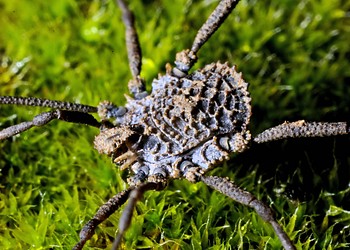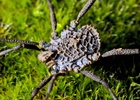Opiliones
Harvestmen
Axel Schönhofer and Marshal Hedin


This tree diagram shows the relationships between several groups of organisms.
The root of the current tree connects the organisms featured in this tree to their containing group and the rest of the Tree of Life. The basal branching point in the tree represents the ancestor of the other groups in the tree. This ancestor diversified over time into several descendent subgroups, which are represented as internal nodes and terminal taxa to the right.

You can click on the root to travel down the Tree of Life all the way to the root of all Life, and you can click on the names of descendent subgroups to travel up the Tree of Life all the way to individual species.
For more information on ToL tree formatting, please see Interpreting the Tree or Classification. To learn more about phylogenetic trees, please visit our Phylogenetic Biology pages.
close boxThe presented phylogeny now seems widely accepted (Hansen and Soerensen 1904, Shultz 1998, Giribet et al. 2010). Previous hypotheses proposed a closer relationship of Dyspnoi and Laniatores based on molecular data and cladistic analyses (Giribet et al. 2002), or Cyphophthalmi with Dyspnoi and Eupnoi, based on ovipositor morphology (Martens 1986). The Cyphophthalmi had once been discussed as not belonging to Opiliones, for example because of possessing a spermatopositor instead of a true penis (Savory 1977).
Introduction
Opiliones are the third largest order within Arachnida, currently with about 6500 described species. Body lengths range from below 1 mm to over 23 mm. Opiliones species inhabit all continents except for Antarctica, and can be very abundant in terrestrial ecosystems. Most species show a high dependence on humidity and few groups have adapted to drier habitats. Low vagility in many groups makes them interesting subjects for studies of speciation and biogeography.
Harvestmen have adapted to a variety of lifestyles from troglobitic and epigeic to rock dwelling and a few fully arboreal species. The best-known taxa are the long-legged Eupnoi harvestmen, although they comprise less than a third of the total opilionid diversity. The majority of species are predators but a few groups can feed on vegetable and other organic matter and are regularly seen as scavengers.
Fossil harvestmen date back to 410 Mio year, featuring a species already very similar in internal structure to modern long-legged Eupnoi (Dunlop et al. 2004). The male of Eophalangium sheari possesses a penis and the female possesses an ovipositor, indicating that the split into Opiliones suborders must have occurred even earlier.
As general reference, the book edited by Pinto-da-Rocha et al. (2007) is recommended.
Characteristics
Opiliones have a compact body with the prosoma broadly fused to the opisthosoma. Unlike other arachnids, most harvestmen show direct sperm transfer, with males possessing a penis for direct insemination. Other unique features are the scent-glands on the opisthosoma, which are mainly used for chemical defense. The mouthparts include three-segmented chelicerae and the oral opening is unusually wide for arachnids. They possess no pumping stomach and can feed on coarse particles making them susceptible to endoparasites. Most harvestmen possess two eyes, often situated on an eye mound. Unlike many other arachnids they show complex social or sub-social behavior, especially in tropical and subtropical Eupnoi, where aggregations of many thousand animals are common.
Systematic and Taxonomy
The systematics and taxonomy is based on features of the male genital morphology with changes in functionality indicating family level, while specific features are often useful for identification to species level. Suborder systematic is based on armature of pedipalps, different claw settings on palps and legs and many other morphological features, elaborated in the respective chapters. The systematic is supported by molecular data, as well (e.g. Giribet et al. 2010).
References
Dunlop, J. A., L. I. Anderson, H. Kerp and H. Hass. 2004. A harvestman (Arachnida: Opiliones) from the Early Devonian Rhynie cherts, Aberdeenshire, Scotland. Earth and Environmental Science Transactions of the Royal Society of Edinburgh 94(04): 341-354.
Giribet, G., G. D. Edgecombe, W. C. Wheeler and C. Babbitt. 2002. Phylogeny and systematic position of Opiliones: a combined analysis of chelicerate relationships using morphological and molecular data. Cladistics 18:5-70.
Giribet, G., M. Rambla, S. Carranza, J. Baguñà, M. Riutort and C. Ribera. 1999. Phylogeny of the arachnid order Opiliones (Arthropoda) inferred from a combined approach of complete 18S and partial 28S ribosomal DNA sequences and morphology. Molecular Phylogenetics and Evolution 11:296–307.
Hansen, H. J. and W. Sørensen. 1904. On two orders of Arachnida Opiliones, especially the suborder Cyphophthalmi, and Ricinulei, namely the family Cryptostemmatoidae. Cambridge University Press.
Martens, J. 1978. Weberknechte, Opiliones. Gustav Fischer Verlag, Jena.
Martens, J. 1980. Versuch eines Phylogenetischen Systems der Opiliones. In: Gruber, J. (ed.). 8. Internationaler Arachnologen-Kongress, Wien 1980, Verhandlungen 1: 355-360.
Martens, J. 1986. Die Grossgliederung der Opiliones und die Evolution der Ordnung (Arachnida). In Barrientos, J.A. (ed.) Actas X Congreso Internacional de Aracnologia (Jaca, Spain, September 1986) 1:289-310.
Martens, J., U. Hoheisel, and M. Götze. 1981. Vergleichende Anatomie der Legeröhren der Opiliones als Beitrag zur Phylogenie der Ordnung (Arachnida). Zoologische Jahrbücher, Abteilung für Anatomie und Ontogenie der Tiere 105:13-76.
Martens, J. and W. Schawaller. 1977. Die Cheliceren-Drüsen der Weberknechte nach rasteroptischen und lichtoptischen Befunden (Arachnida: Opiliones). Zoomorphology 86:223-270.
Pinto da Rocha, R., G. Machado and G. Giribet. 2007. The Harvestmen. The Biology of Opiliones. (eds.), Harvard University Press, Cambridge.
Savory, T. H. 1977. Cyphophthalmi: the case for promotion. Biological Journal of the Linnean Society 9:299-304.
Information on the Internet
- The Arachnology Home Page: Opiliones
- Opiliones Classification. Adriano B. Kury.
Title Illustrations

| Scientific Name | Holoscotolemon querilhaci |
|---|---|
| Specimen Condition | Live Specimen |
| Identified By | Axel Schoenhofer |
| Life Cycle Stage | adult |
| Copyright |
© 2011 Axel Schönhofer

|
| Scientific Name | Phalangium opilio |
|---|---|
| Specimen Condition | Live Specimen |
| Identified By | Axel Schoenhofer |
| Sex | m |
| Life Cycle Stage | adult |
| Copyright |
© 2011 Axel Schönhofer

|
| Scientific Name | Siro boyerae |
|---|---|
| Specimen Condition | Live Specimen |
| Identified By | Axel Sch?nhofer |
| Sex | m |
| Life Cycle Stage | adult |
| Copyright |
© 2011 Axel Schönhofer

|
| Scientific Name | Ortholasma rugosum |
|---|---|
| Specimen Condition | Live Specimen |
| Identified By | Axel Sch?nhofer |
| Sex | m |
| Life Cycle Stage | adult |
| Copyright |
© 2011 Axel Schönhofer

|
About This Page
Axel Schönhofer

San Diego States University, San Diego, California, USA
Marshal Hedin

San Diego State University, San Diego, California, USA
Correspondence regarding this page should be directed to Axel Schönhofer at
Axel.Schoenhofer@uni-mainz.de
and Marshal Hedin at
mhedin@sciences.sdsu.edu
Page copyright © 2012 Axel Schönhofer and Marshal Hedin
 Page: Tree of Life
Opiliones. Harvestmen.
Authored by
Axel Schönhofer and Marshal Hedin.
The TEXT of this page is licensed under the
Creative Commons Attribution-NonCommercial License - Version 3.0. Note that images and other media
featured on this page are each governed by their own license, and they may or may not be available
for reuse. Click on an image or a media link to access the media data window, which provides the
relevant licensing information. For the general terms and conditions of ToL material reuse and
redistribution, please see the Tree of Life Copyright
Policies.
Page: Tree of Life
Opiliones. Harvestmen.
Authored by
Axel Schönhofer and Marshal Hedin.
The TEXT of this page is licensed under the
Creative Commons Attribution-NonCommercial License - Version 3.0. Note that images and other media
featured on this page are each governed by their own license, and they may or may not be available
for reuse. Click on an image or a media link to access the media data window, which provides the
relevant licensing information. For the general terms and conditions of ToL material reuse and
redistribution, please see the Tree of Life Copyright
Policies.
- First online 04 July 2012
- Content changed 04 July 2012
Citing this page:
Schönhofer , Axel and Marshal Hedin. 2012. Opiliones. Harvestmen. Version 04 July 2012 (under construction). http://tolweb.org/Opiliones/2556/2012.07.04 in The Tree of Life Web Project, http://tolweb.org/




6.250a.jpg)

6.100a.jpg)


 Go to quick links
Go to quick search
Go to navigation for this section of the ToL site
Go to detailed links for the ToL site
Go to quick links
Go to quick search
Go to navigation for this section of the ToL site
Go to detailed links for the ToL site